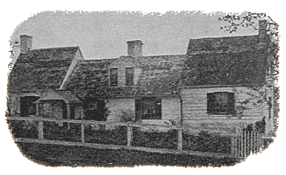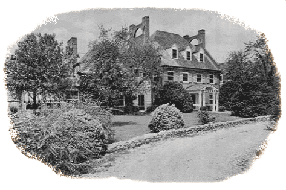 |
| Hollin Hall | ||
|
Hollin Hall, once the home of George Mason's third son, Thomson Mason, was located 3 miles southwest of the city of Alexandria on Little Hunting Creek. During the latter half of the 18th century it was adjacent to, and west of, George Washington's Mount Vernon. Through deeds of gift in 1781 and 1786, George Mason of Gunston Hall passed ownership of this land to his son, Thomson Mason. The deeded land consisted of four tracts, totaling 676 acres. Thomson would eventually set up his residence on these four tracts. Previously, as was common in the 18th century, the Mason family rented this land to tenants, who cultivated the land for them.1 After receiving the deeds to the property, Thomson Mason and his wife, Sarah McCarty Chichester, began building a house suitable to their position in society. By December of 1788, in time to celebrate Christmas, they were living in their new dwelling.2 Yet evidence survives to show the house was still not complete; for in May of 1792, George Mason wrote his son John about the difficulty he was having getting materials for their front porch.3 Thomson and his family lived a lifestyle common to many wealthy planters along the Potomac River. They owned a large number of slaves with which they grew an assortment of crops, the largest being wheat. Surviving to give us some indication of what life was like on Thomson's plantation are The Letters of Elijah Fletcher. Fletcher was a schoolteacher from Vermont who, in 1810, taught at the nearby Alexandria Academy and boarded at the Mason plantation. During his stay he wrote to his family describing Virginia customs, Thomson Mason (referred to as General Mason) and life at Hollin Hall.4
Post-Mason Ownership In 1919, Mr. and Mrs. Harley Wilson bought the plantation whereupon they began making many changes. One significant addition was a new residence built on the site of the original house. The new residence would have befitted Thomson for it was three stories tall and contained sixteen rooms. In 1935 Mr. Wilson died, leaving the building vacant for some time. Mr. and Mrs. Merle Thorpe bought it during World War II, and it stayed in their possession until Mount Vernon Unitarian Church bought the house and the surrounding the buildings in 1958.7
1. The Diaries of George Washington, Vol. 1, p. 248. General Mason sent one of them two or three miles with some message. He was rather lazy, and thought he would have a ride. He went in to the pasture and caught my mare, and took a little negro boy on behind him and rode off. It was found out soon, and when he returned they first tied up the boy and whipt him about a quarter of an hour. . . They then took the man, and I will assure you, they shew him no mercy. Being from Vermont, Fletcher may not have been exposed to the institution of slavery. This may account for the seeming shock that he received when he witnessed such cruelty inflicted upon the Mason slaves. However distasteful this early exposure was to Fletcher it failed to prevent him from staying in Virginia, and owning his own slaves. Pictured: Drawing of Original Hollin Hall, Mutual Assurance Plan; Hollin Hall Spinning House, from W. H. Snowden, Some Old Historic Landmarks of Virginia and Maryland Described in a Hand-Book for Tourist Over the Washington-Virginia Railway, 1904. Wilson's Hollin Hall, Public auction advertisment, N.C. Hines and Sons, 1941. |

 Thomson Mason lived at Hollin Hall until his death in 1820. Upon his death, the plantation was bequeathed to his second son, George W. Mason. Planning to move to lands he inherited in Kentucky in 1822, George placed an advertisement in the popular 19th-century magazine American Farmer offering to sell Hollin Hall. According to his advertisement the plantation consisted of the main house, its outbuildings, and 740 acres of land.
Thomson Mason lived at Hollin Hall until his death in 1820. Upon his death, the plantation was bequeathed to his second son, George W. Mason. Planning to move to lands he inherited in Kentucky in 1822, George placed an advertisement in the popular 19th-century magazine American Farmer offering to sell Hollin Hall. According to his advertisement the plantation consisted of the main house, its outbuildings, and 740 acres of land.